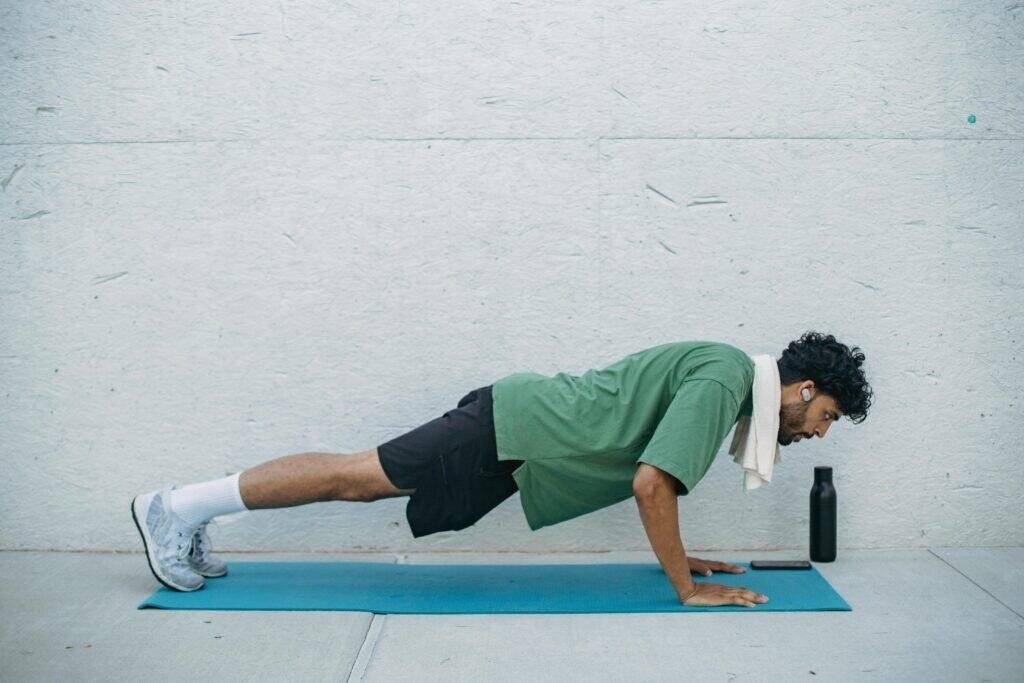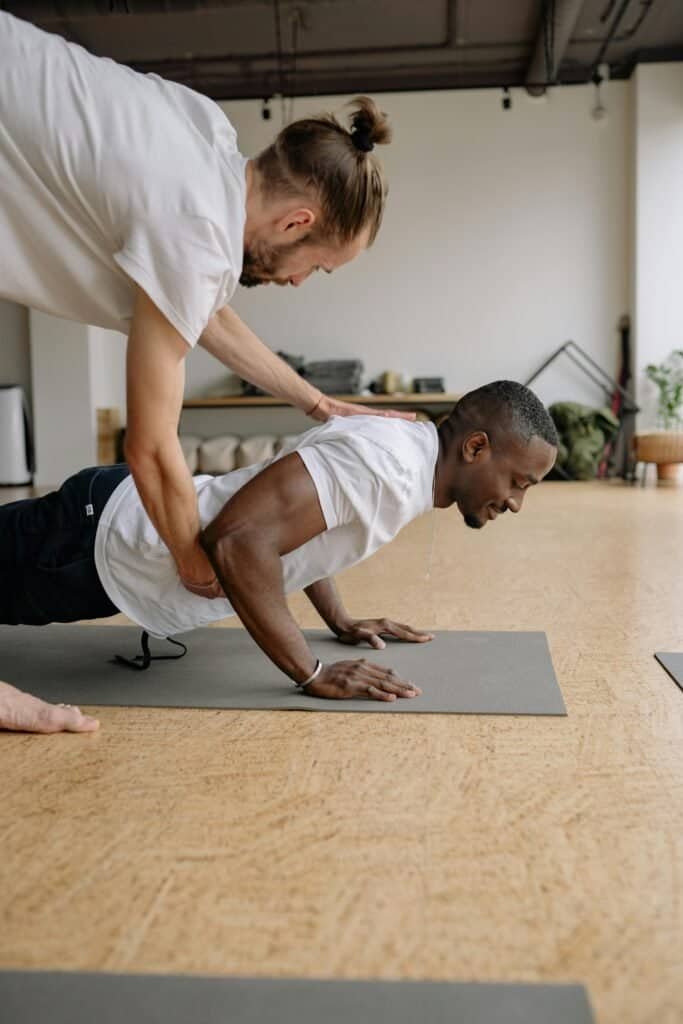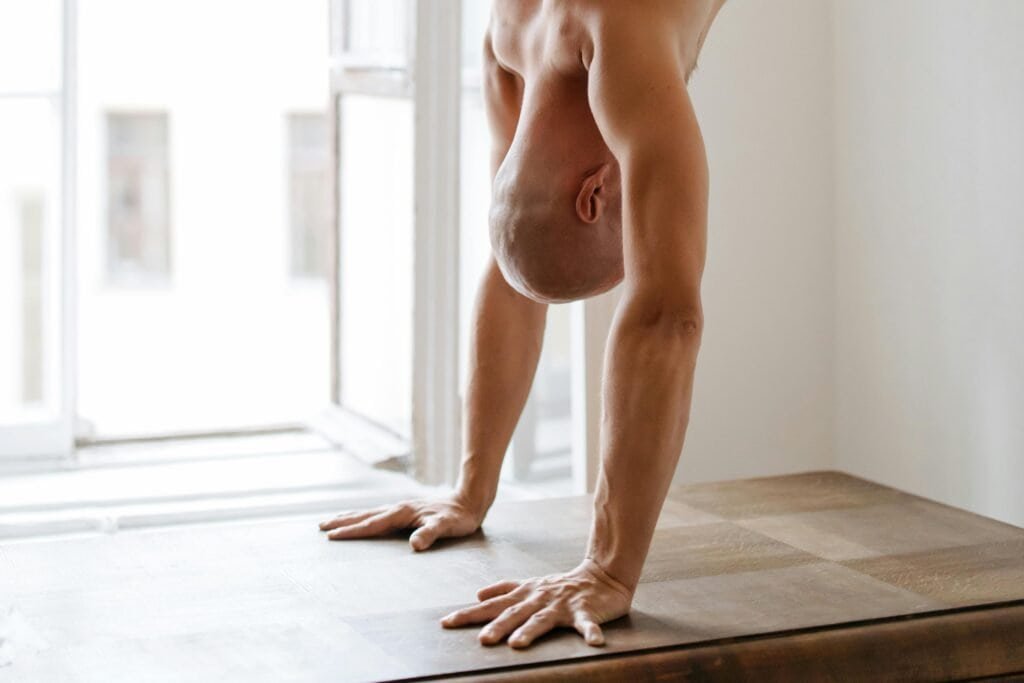Can You Really Build Muscle Without Equipment?
Build Muscle at Home Without Equipment Bodyweight Workout: Many people believe you need a gym membership, dumbbells, and machines to gain muscle. The truth is that your body is already the best piece of equipment you own. With structured bodyweight training, progressive overload, and the right nutrition, you can absolutely build muscle at home without equipment. This guide will walk you step by step through the principles, exercises, and routines to maximize muscle growth using only bodyweight workouts.

Why Bodyweight Training Works for Muscle Growth
Building muscle relies on three main factors:
- Mechanical tension – muscles must work against resistance.
- Metabolic stress – the “burn” that signals adaptation.
- Progressive overload – gradually increasing difficulty over time.
Bodyweight exercises can provide all three if performed correctly. By adjusting leverage, tempo, and reps, you can make movements challenging enough to stimulate growth, even without external weights.
The Benefits of Building Muscle at Home Without Equipment
1. Convenience
You can train anywhere—your bedroom, living room, or even outdoors.
2. Cost-Effective
No gym fees, dumbbells, or fancy machines required.
3. Functional Strength
Bodyweight training improves mobility, stability, and control, not just size.
4. Scalable Difficulty
Movements can be modified from beginner to advanced levels.
Principles of Bodyweight Muscle Growth
Before jumping into exercises, it’s essential to understand the core training principles that make bodyweight workouts effective.
Progressive Overload Without Weights
You don’t need heavier dumbbells to overload your muscles. Instead, you can:
- Increase reps or sets.
- Slow down tempo (e.g., 5-second eccentric push-ups).
- Change leverage (e.g., elevated feet push-ups, single-leg squats).
- Shorten rest periods.
Time Under Tension
Keeping muscles under strain for longer encourages hypertrophy. Example: 40–60 seconds of controlled movement per set.
Training Frequency
For optimal results, aim to train each muscle group 2–3 times per week.

The Best Bodyweight Exercises for Building Muscle at Home
Upper Body
Push-Ups (Chest, Shoulders, Triceps)
- Standard push-ups target the chest and triceps.
- Variations: wide push-ups (chest), diamond push-ups (triceps), decline push-ups (upper chest).
Dips (Triceps, Chest)
- Use chairs or a sturdy surface.
- Progression: from bent-knee dips to straight-leg dips.
Pike Push-Ups (Shoulders)
- Push your hips high and lower yourself like a handstand push-up.
- Advanced: wall-assisted handstand push-ups.
Inverted Rows (Back, Biceps)
- Use a sturdy table or bar at home.
- Variations: change foot placement to increase difficulty.
Lower Body
Squats (Quads, Glutes, Hamstrings)
- Start with bodyweight squats.
- Progressions: jump squats, pistol squats, Bulgarian split squats.
Lunges (Quads, Glutes)
- Forward, reverse, or walking lunges.
- Advanced: explosive jumping lunges.
Glute Bridges (Glutes, Hamstrings)
- Lie on your back, lift hips upward.
- Advanced: single-leg glute bridges.
Calf Raises
- Perform on stairs for deeper range.
- Hold contractions for 2–3 seconds at the top.
Core
Plank (Abs, Core Stability)
- Keep body aligned.
- Variations: side plank, plank with shoulder taps.
Leg Raises (Lower Abs)
- Lie flat, lift legs slowly.
- Advanced: hanging leg raises (if you have a bar).
Mountain Climbers
- Builds endurance and core strength.
Hollow Body Hold
- Advanced core stabilization exercise used by gymnasts.

Structuring Your Home Bodyweight Workout Plan
Step 1: Warm-Up (5–10 minutes)
- Jumping jacks, high knees, dynamic stretches.
Step 2: Workout Split Options
- Full-Body Routine (3x per week) – ideal for beginners.
- Upper/Lower Split (4x per week) – intermediate level.
- Push/Pull/Legs Split (6x per week) – advanced lifters.
Step 3: Reps, Sets, and Rest
- Beginners: 3 sets of 8–12 reps per exercise.
- Intermediate: 4–5 sets of 10–15 reps.
- Advanced: 5+ sets, progressive variations.
- Rest: 60–90 seconds between sets.
Sample Full-Body Bodyweight Workout (Beginner to Advanced)
Beginner Full-Body Routine
- Push-Ups – 3×10
- Squats – 3×12
- Glute Bridges – 3×15
- Plank – 3x30s hold
Intermediate Full-Body Routine
- Decline Push-Ups – 4×12
- Bulgarian Split Squats – 4×10 each leg
- Inverted Rows – 4×12
- Leg Raises – 4×12
Advanced Full-Body Routine
- Handstand Push-Ups – 5×6–8
- Pistol Squats – 5×6 each leg
- Archer Push-Ups – 5×10
- Hanging Leg Raises – 5×12–15
Nutrition for Building Muscle at Home
Even the best workout plan won’t build muscle without proper nutrition.
Protein Intake
- Aim for 1.6–2.2 g protein per kg bodyweight daily.
- Sources: chicken, eggs, beans, lentils, tofu, fish.
Caloric Surplus
- Consume slightly more calories than you burn to fuel growth.
Hydration
- 3–4 liters of water daily supports recovery and performance.
Recovery and Rest
Muscles grow outside the workout, during rest.
- Sleep: Aim for 7–9 hours.
- Recovery: Include stretching, foam rolling, and light cardio.
- Avoid overtraining—quality over quantity.
Common Mistakes to Avoid
- Skipping progression – don’t stick with easy variations forever.
- Poor form – increases risk of injury.
- Neglecting legs – squats and lunges are essential.
- Inconsistent training – results require consistency.
Advanced Tips for Faster Muscle Growth at Home
- Use tempo training: slow eccentrics (5 seconds down, 1 up).
- Add isometric holds: pause mid-rep for extra tension.
- Supersets & circuits: combine push/pull or upper/lower moves.
- Track your progress: log reps, sets, and improvements weekly.

Conclusion: Yes, You Can Build Muscle at Home Without Equipment
Building muscle at home without equipment bodyweight workout routines is 100% possible if you follow the right strategy. Focus on progression, balance upper and lower body, fuel your muscles with protein-rich meals, and stay consistent. With time, you’ll develop strength, muscle mass, and a lean, functional physique—all without stepping into a gym.
Want to take your progress even further? Check out these related guides that dive deeper into the essentials you’ll need to succeed:
Common Mistakes That Stop You From Building Muscle at Home
Best Bodyweight Exercises for Full Body Muscle Growth at Home
How to Increase Workout Intensity for Faster Muscle Gains at Home
Can You Really Build Muscle With Just Push-Ups, Squats, and Pull-Ups?
The Science Behind Progressive Overload in Home Bodyweight Training
How to Create a Weekly Home Workout Plan for Muscle Building
Best Nutrition Tips to Support Muscle Growth from Home Workouts
How Long Does It Take to See Results from Bodyweight Training?
Beginner to Advanced: How to Progress Your Home Workouts for Continuous Muscle Gains
